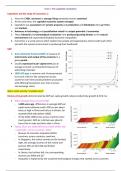Lecture notes
EC107 term 1 and term 2 notes
- Module
- EC107 Economics 1
- Institution
- The University Of Warwick (UoW)
These notes got me 86% in the mini-test. They are very pretty notes (because I am a perfectionist), so use these to help you do well in your first year. You are welcome! :) Find me on Linked In @HollyHalai for any questions on the course (I did economics and GSD).
[Show more]



